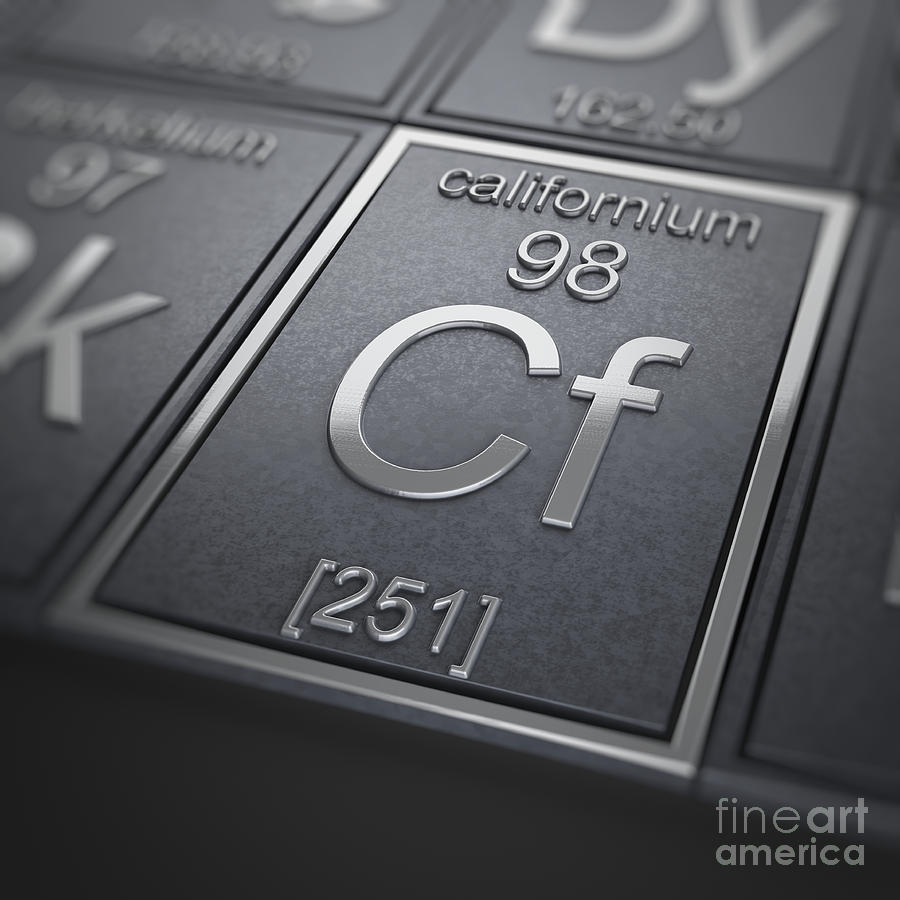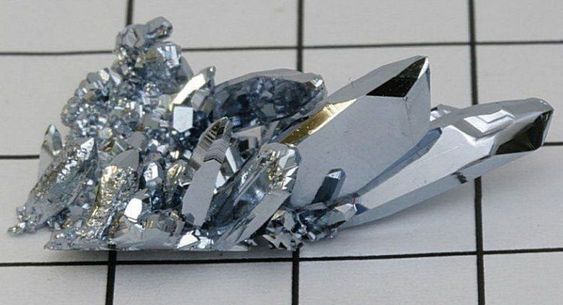Identity.
Californium, element number 98, is a man-made marvel. Unlike most
elements on the periodic table, it doesn't exist naturally on Earth.
Instead, it's forged in the fiery hearts of nuclear reactors,
bombarded into existence from its lighter sibling, curium. This
silvery-white metal shines brightly with radioactivity, emitting
powerful neutrons that make it a valuable tool in scientific
exploration and industrial applications. While its fleeting existence
limits its use, this Californian creation remains a fascinating
testament to human ingenuity and the wonders hidden within the atom.
History.
In 1950, amidst the bustling halls of the Lawrence Berkeley National
Laboratory (then known as the University of California Radiation
Laboratory), history was made. A team of scientists led by Glenn
Seaborg, the "father of transuranium elements," ushered in a new
element: Californium (Cf). Their creation wasn't found amongst Earth's
rocks and minerals, but rather materialized in the heart of a powerful
cyclotron, where they bombarded curium-242 with helium ions. This
atomic alchemy yielded californium-245, initially existing for only 44
minutes.
The journey to isolate and identify this new element was arduous.
Meticulous chemical separations were employed, extracting a mere
5,000 atoms - a testament to the team's perseverance. Their
success earned Californium its namesake, honoring the university
and state where it was born. Later, other isotopes with longer
half-lives were discovered, paving the way for further
exploration.
Californium's short history is intricately woven with scientific
advancement. It played a crucial role in confirming the existence
of new transuranium elements and served as a stepping stone to
heavier creations like einsteinium and fermium. While its rarity
and radioactivity limit its everyday use, Californium continues to
be a valuable tool in research, notably as a potent neutron source
for scientific studies and cancer treatment applications. Its
story exemplifies the pursuit of knowledge and the incredible
discoveries that lie within the realm of the unseen.
Usage.
Californium, though rare and radioactive, finds its niche in diverse
spheres. Think portable metal detectors sniffing out gold or oil
exploration probes guided by its neutron glow. It even helps fight
cancer, delivering targeted radiation doses. While fleeting, this
Californian creation shines brightly in scientific research and
industrial applications, a testament to human ingenuity.
-
Neuron Source: Californium-252 is an excellent neutron
emitter, producing millions of neutrons per second. This property
makes it useful in a variety of applications, including: Starting
up nuclear reactors: Californium can be used to provide the
initial burst of neutrons needed to start up a nuclear reactor.
Neutron activation analysis: Californium can be used to bombard
materials with neutrons, which can cause the materials to emit
characteristic radiation that can be used to identify the elements
present. This technique is used in a variety of applications,
including forensic analysis, environmental monitoring, and medical
imaging. Portable neutron sources: Californium can be used to
create portable neutron sources that can be used for a variety of
applications, such as well logging, metal detection, and
explosives detection.
-
Cancer Treatment: Californium-252 can be used to treat
certain types of cancer, such as cervical cancer and brain tumors.
The high-energy neutrons emitted by californium can kill cancer
cells without damaging healthy tissue.
-
Industrial Application: Californium can be used in a
variety of industrial applications, such as: Level gauges:
Californium can be used to measure the level of liquids in tanks
and pipes. Moisture gauges: Californium can be used to measure the
moisture content of soil and other materials. Weld inspection:
Californium can be used to inspect welds for cracks and other
defects.
-
Research: Californium is used in a variety of research
applications, such as: Studying the properties of transuranium
elements: Californium can be used to study the properties of other
transuranium elements, which are elements that are heavier than
uranium. Developing new nuclear technologies: Californium can be
used to develop new nuclear technologies, such as new types of
nuclear reactors and fuel.
Some of the benefits of using Californium are:
-
Californium-252 emits an exceptional number of neutrons compared
to other readily available sources. This makes it ideal for
applications requiring strong neutron fluxes, such as: Neutron
Activation Analysis: Identifying elements in various materials
like soil, minerals, or even for forensic investigations. Portable
Neutron Sources: Used in oil well logging, explosives detection,
and even in-field metal analysis. Nuclear Reactor Startup:
Providing the initial neutron "kickstart" to initiate the chain
reaction.
-
Californium-252's targeted neutron radiation proves valuable in
treating specific cancers: Brachytherapy: For localized tumors,
Californium sources can be placed directly within or near the
tumor, maximizing effectiveness and minimizing damage to healthy
tissue. Neutron Activation Therapy: In certain cases, Californium
activates Boron atoms within cancer cells, triggering their
destruction.
-
Californium offers unique solutions in various industries:
Non-destructive Testing: Inspecting welds for cracks or other
flaws in pipelines and critical structures. Moisture Gauges:
Accurately measuring moisture content in soil, construction
materials, and agricultural products. Level Gauges: Determining
liquid levels in tanks and pipes efficiently, especially for
opaque or hazardous materials.
-
Californium plays a crucial role in research: Understanding
Transuranic Elements: Its properties shed light on other heavy
elements beyond uranium, aiding in scientific exploration and
potentially future technological advancements. Developing New
Technologies: Research with Californium contributes to the
development of safer and more efficient nuclear reactors and fuel
sources.
Sources.
Forget mining for gold – californium is a man-made marvel! Unlike
naturally occurring elements, it's crafted in nuclear reactors.
Imagine bombarding curium with helium ions, like an atomic sculptor
chipping away at the invisible. This delicate process yields microgram
quantities, primarily from two facilities in the US and Russia. While
fleeting in existence, californium shines brightly in research and
industry, a testament to the wonders created within the atom's heart.

